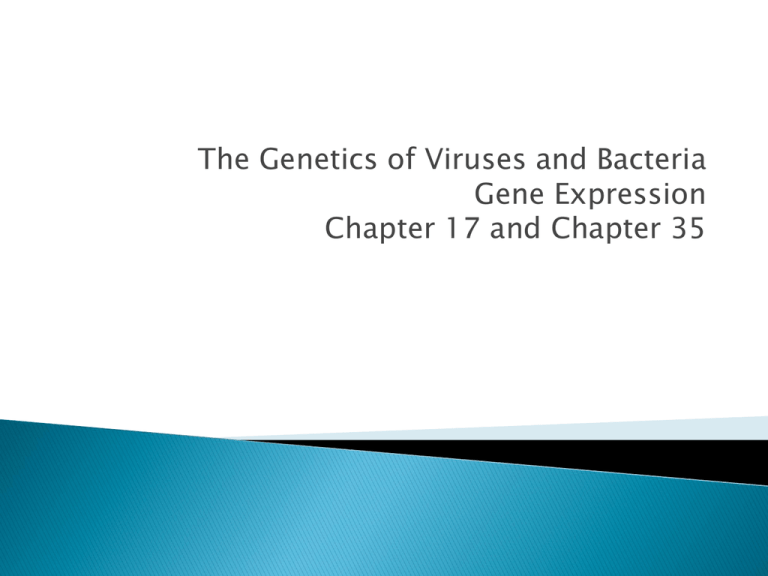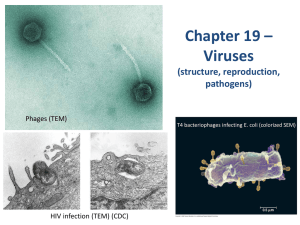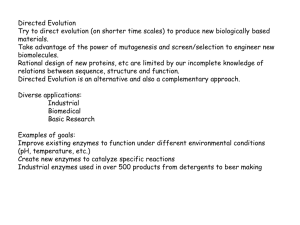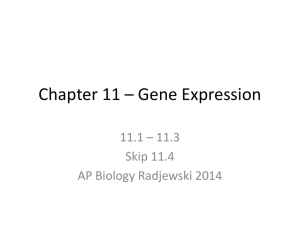
The Genetics of Viruses and Bacteria
Gene Expression
Chapter 17 and Chapter 35
Discovery – researchers discovered viruses by
studying the TMV (tobacco mosaic virus)
◦ Infected sap was sprayed on other plants; Beijerinck
concluded that the pathogen was reproducing
because the concentration of it was undiluted in
each new generation of infected plants,
◦ Stanley crystallized the pathogen known as TMV
Viral structure
Viral Genomes – include double strand DNA, single
stranded DNA, double strand RNA, or single stranded
RNA
Linear or circular
May have four genes or several hundred
Capsids and Envelopes
Capsid – protein coat that encloses the viral genome
Rod-shaped, polyhedral, or complex
Composed of small protein spherical subunits call
capsomeres
Envelope – membrane that coats viral capsids
Helps virus infect host
Bacteriophages – most complex virus with a icosohedral
head; named T1 – T7
Viral Reproduction
Host Range – virus contain viral proteins that fit into
specific cell surface receptor sites of the host
Some ranges may be broad while others are small or even
one host ranges
Mechanisms – viruses commandeer their host cell
machinery and produce copies of themselves
Patterns of viral genome replication (viral protein
production)
DNA to DNA = virus will use hot cells DNA polymerase to
copy its DNA genome
RNA to RNA = most host cells do not have an enzyme to
copy RNA, the virus cell will carry RNA replicase, an enzyme
that uses viral RNA as a template produce complementary
RNA
RNA to DNA to RNA – viral cell carries reverse transcriptase,
an enzyme that transcribes DNA from an RNA template
Lytic Cycle – virulent phages reproduce only
by this mechanisms; virulent phages lyse the
host cells resulting in host cell death
Phage attaches to cell surface
Viral surface proteins recognize receptor sites of the
host cell
Phage contract sheath and inject viral genome
ATP stored in phage tailpiece powers contraction
Capsid ghost is left behind; capsid with no genetic
material present
Hydrolytic enzymes destroy host cell’s DNA
Host cell transcribes then translates viral proteins
Phage genome directs the host cell to
produce phage components: DNA and capsid
proteins
Using nucleotides from its degraded genome, the
host cell makes copies of the phage genome
Host assembles tail fibers, phage tails, and
polyhedral heads
Phage components assemble spontaneously
through weak hydrogen bond interactions
Cell lyses and releases phage particles
Lysozymes specified by the viral genome digest
bacteria cell wall
Lytic cycle takes 20–30 minutes and may increase
the population a hundredfold
Lysogenic Cycle – coexistence of host and phage
Viral replication where the viral genome becomes
incorporated into the bacterial genome
Phage binds to bacteria surface
Phage injects DNA into host
DNA forms a circle and either begins lytic or lysogenic
cycle
DNA crosses over into the bacterial DNA and becomes a
prophage
Prophage genes are copied along with bacteria genome. As
cell divides the prophage is passed to each new daughter
cell
Lysogenic Cell – host cell carrying a prophage in its
chromosome
Excision (exiting) of the prophage from the bacteria
chromosome may begin the lytic cell
Animal Viruses
◦ Provirus – viral DNA that inserts into a host cell
chromosome (animals chromosome)
◦ Retrovirus – RNA virus that uses reverse
transcriptase to transcribe DNA from the viral RNA
(HIV)
◦ Emerging Viruses – make a sudden impact; most
likely an existing virus that has expanded its host
range
Bacterial chromosome is a circular, double
stranded DNA found in the nucleoid region
Plasmids – extra chromosomal units found in
most bacteria that contain extra genes
(double stranded rings)
Binary Fission – reproduction preceded by
DNA replication
Genetic Recombination – gene transfer
between bacteria and other sources of DNA
◦ Transformation – gene transfer during which a
bacterial cell assimilates foreign (naked) DNA from
its surroundings (Avery’s experiment, chapter 16)
◦ Transduction – gene transfer from one bacteria to
another by a bacteriophages
Host cell DNA is packaged along with phage DNA
during the lytic cycle and that phage infects another a
host
Conjugation – direct transfer of genes
between two cells that are temporarily joined
via a sex pilli (ability to form sex pilli is found
in the genes of the F plasmid)
Characteristics of Plasmids
Contain a few genes, not necessary for survival
Replicate independently or in synchrony of the
bacterial chromosome
No extracellular stage, unlike viruses
F plasmid – “fertility” plasmid consisting of 25 genes
which are involved in production of sex pilli
Replicates in synchrony of the bacterial chromosome
Each daughter cell will be F+
R plasmid – “resistance” plasmid carrying up to ten genes
fro antibiotic resistance
Increased antibiotic use has produced many pathogenic
resistant strains of bacteria
Transposons – pieces of DNA that move from
different locations on the chromosome
(McClintock, 1940’s)
◦ Causes mutations by interrupting the transcription
of mRNA, and therefore, disrupting the translation
of that protein
◦ Increase/decrease protein production by inserting
within a regulatory gene sequence that controls
transcription rates
Operon – a system that allows for the turning
on or the turning off of metabolic activites
◦ Operator – the DNA switch found within the
promoter region
◦ Repressor – protein that may shut the operon down
by binding to the operator so the RNA polymerase
can not bind to the promoter to transcribe RNA
Product of a regulator gene
TRP Operon – regulates the production of
repressible enzymes by producing the amino
acid tryptophan
Five genes encode the polypeptides that make the
enzymes
When “on”, RNA polymerase binds to the DNA and
transcribes the gene’s; inactive repressor; no
tryptophan present
When “off”, tryptophan (corepressor) binds to the
inactive repressor making it active allowing it to bind to
the operator; tryptophan present
When tryptophan is present, it inhibits its own
production by activating the repressor
LAC Operon – production of enzymes to take up
and metabolize lactose
Three genes code for the enzymes necessary to
metabolize lactose
When “off”, lactose is absent, repressor will bind to
operator stopping the transcription by RNA polymerase
to produce the enzymes
When “on”, lactose present, repressor in inactive
because of an inducer (allolactose) that will bind to the
repressor rendering it inactive
Allolactose is an isomer of lactose that enters the cell
and induces the binding of the active repressor to the
operator










